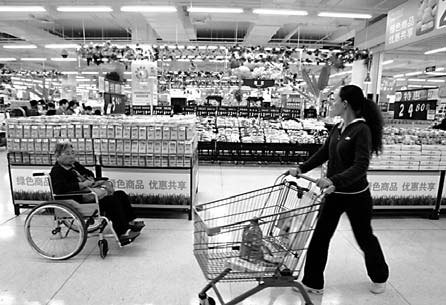Do consumers ever think about how much energy they consume as they shop in a bright supermarket with a moderate temperature whether it's summer or winter?

Environmental change is affecting every one in the world. The public is seeing increasingly turbulent weather, blizzards, heatwaves and hurricanes. With the growth of public awareness on climate change and environmental protection, the answer is increasingly, "yes".
After the global retailing giant Wal-Mart opened its first energy-efficient store in Beijing's Wangjing area at the end of October, Beijingers shopping there are helping the city improve its environment.
The new store has light-emitting-diodes (LED) as its major lighting source and sliding glass doors are used in refrigerators and coolers in a bid to conserve energy and reduce carbon emissions. In addition, water running from the refrigeration system is purified and reused.
To save more energy, the entire store is equipped with motion sensors to control lighting during non-peak hours and in low traffic areas.
Compared to a typical store in 2005, the new outlet will consume 23 percent less electricity and 17 percent less water annually, Wal-Mart says.
Industry insiders say that Wal-Mart's actions might not make a very obvious contribution to establish a green management mode in China's retailing industry, however, it at least shows a new trend for other retailers.
They believe that under the market mechanism, manufacturers, service providers and consumers can become a very significant force in protecting the environment.
The new Beijing Wal-Mart store is a part of the efforts by the global retailing giant to build up it "green" retailing kingdom and a "green" global supply chain. The world's biggest retailer is constantly promoting their environmental friendly notions in China and across the globe.
Ron Virta, vice-president of the merchandise development of Wal-Mart China, says that the company's existing stores will be fitted with more sustainable equipment, with the old machinery serving as a back up.
The retailer is planning to completely refit all of its 113 stores in the country in three to five years.
In cooperation with the Environmental Defense Fund (EDF), a US-based nonprofit organization, Wal-Mart is actively getting engaged in the Green Supply Chain Initiative.
Led by EDF, the initiative is aimed at working with individual suppliers and manufacturers on energy saving and other issues in conjunction with China's trade and government leadership. And it is expected to extend to other US and European retailers, covering another 20,000 factories.
Green Supply Chain is a new concept and an ambitious goal for Wal-Mart, which has three goals: to be supplied 100 percent by renewable energy; to create zero waste; and to sell products that sustain Wal-Mart's resources and the environment.
Next year Wal-Mart will impose higher environmental and social standards on its 20,000 suppliers in China in a bid to build up a more environmentally and socially responsible global supply chain. And the stricter standards will apply to their sub-contractors as well.
And under Wal-Mart's new supplier agreement which is due to take effect next January, cooperating Chinese factories will be asked to certify compliance with local laws and regulations on air emissions, wastewater discharges and its management of toxic substances and hazardous waste disposal.
EDF and Wal-Mart have also announced a partnership to develop strategies and monitor Wal-Mart's efforts to reduce plastic shopping bag waste by an average of one-third per store from 2008 levels by 2013.
"We think sustainability is essential to our future success as a retailer and to meet the expectations of customers," said Lee Scott, president and CEO of Wal-Mart.
Suppliers need to be seeing environmental performance requirements in supplier contracts, preferential purchasing terms for those that comply and excel, and consequences for those that fail, says Dan Dudek, chief economist of EDF.
Gwen Ruta, vice-president of Corporate Partnerships for EDF, says: "Suppliers are a crucial component of Wal-Mart's environmental impact, since its own efficiency efforts won't keep pace with continued growth."
"Wal-Mart's best chance for engaging suppliers in China and worldwide is to take a holistic approach to products and supplier relationships, showing them problem areas and the environmental and business benefits of addressing them," says Ruta.
Dudek says that Wal-Mart's focus is in line with goals already set by the Chinese government in water and air pollution and energy use which is a welcome additional impetus.
Jiang Zengwei, vice-minister of commerce, says retailing enterprises are big energy consumers in China where energy consumption accounts for 40 percent of operating cost in department stores and retail chains. There is large potential for energy savings.
Jiang says that the Ministry of Commerce has promoted an Energy Conservation Campaign among retailers since last year, aiming to reduce their energy costs by 20 percent by 2010.
Impacts from the Green Supply Chain could expand to China's small and medium-sized enterprises in the long run. An official from China Association of Small and Medium Enterprises says SMEs account for 99.8 percent of total number of China's enterprises, creating over 60 percent of the country's GDP.
However, about 80 percent of pollution and emissions from the country's enterprises come from SMEs, he says, adding that an environmental protection mechanism should be built up inside Chinese enterprises in an effort to wholly advance the country's aggressive green efforts.
There would be concern over who can afford the extra investment for energy efficiency, especially as the influence of the US financial crisis is spreading across the globe.
Wal-Mart declines to specify the amount of its environmental protection investment, but says the extra investment in an energy-efficient store pay within three years.
According to a forecast by Wal-Mart, only from its plan to reduce 5 percent of packaging materials by 2013, the company would save about $3.4 billion itself, and save over $11 billion for its global supply chain.
(China Daily November 10, 2008)